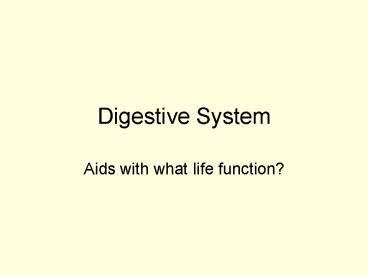Digestive System - PowerPoint PPT Presentation
1 / 16
Title:
Digestive System
Description:
Digestive System Aids with what life function? Mouth The first part of the digestive system where food is ingested and taken into the body. Mechanical digestion ... – PowerPoint PPT presentation
Number of Views:296
Avg rating:3.0/5.0
Title: Digestive System
1
Digestive System
- Aids with what life function?
2
Mouth
- The first part of the digestive system where food
is ingested and taken into the body. - Mechanical digestion begins here. You begin to
chew your food and break it down. - Chemical digestion also begins here. Food is
mixed with saliva that has enzymes that begin to
digest carbohydrates.
3
Digestive Tract
Accessory Organs
1 Mouth
4
Esophagus
- Long tube that connects the mouth to the stomach.
- Muscles contract and relax to move food down the
esophagus. This is called peristalsis. - A valve called a sphincter separates the
esophagus from the stomach.
5
Digestive Tract
Accessory Organs
1 Mouth
2 Esophagus
6
Stomach
- A sac-like muscular organ that is attached to the
esophagus. - When food enters the stomach mechanical digestion
is completed here. Food is churned and turns into
a paste called chime. - Digestive enzymes are mixed with the food to
continue chemical digestion.
7
Digestive Tract
Accessory Organs
1 Mouth
2 Esophagus
3 Stomach
8
Small Intestine
- The long, thin winding tube that food goes
through after it leaves the stomach. - Chemical digestion continues in the small
intestine. - Absorption occurs here through small extensions
in the intestine wall called villi.
9
Digestive Tract
Accessory Organs
1 Mouth
2 Esophagus
3 Stomach
4 Small Intestine
10
Accessory Organs
- Liver makes bile a digestive enzyme that
emulsifies fats to help with their digestion. - Gall Bladder is attached to the liver. It stores
and releases the bile into the small intestine. - Pancreas is a gland that produces enzymes which
help digest carbohydrates, fats and proteins into
the small intestine.
11
Digestive Tract
Accessory Organs
1 Mouth
2 Esophagus
Liver
3 Stomach
Pancreas
Gall Bladder
4 Small Intestine
12
Large Intestine (Colon)
- Digestion and absorption is over. Wider tube
that remaining food waste moves through. - Water is reabsorbed into the body here and
bacteria help make vitamins.
- Appendix is a small sac located near the
start of the large intestine. - Function unknown but might have to do with all
the bacteria that lives in the human digestive
system.
13
Digestive Tract
Accessory Organs
1 Mouth
2 Esophagus
Liver
3 Stomach
Pancreas
Gall Bladder
4 Small Intestine
5 Large Intestine (colon)
Appendix
14
Rectum
- Where feces is stored before it is released from
the body. - The waste in feces has never entered the body.
It is the waste that could not be digested or
absorbed. - It will leave out the anus. An other sphincter
valve open to the outside of the body. The end
of the digestive tract.
- If too much water is absorbed in the large
intestine you will be constipated. If too little
water is absorbed you will have diarrhea.
15
Digestive Tract
Accessory Organs
1 Mouth
2 Esophagus
Liver
3 Stomach
Pancreas
Gall Bladder
4 Small Intestine
5 Large Intestine (colon)
6 Rectum
Appendix
7 Anus
16
Digestive Enzymes
- We use enzymes to digest our food. Why do we
need different enzymes to digest different types
of food? - Why do we have to digest our food?
Nutrient Enzyme End Product
Carbohydrates Amylase
Proteins Peptidase
Lipids Lipase
Monosaccharides (Simple sugars)
Amino Acids
3 Fatty Acids and 1 Glycerol































